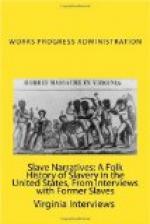“Grandma lived with papa. She was part Indian. As long as papa lived he share cropped and ginned. He worked as long as he was able to hit a lick. He died four miles east out from Sanitobia on Mr. Hayshaws place. What I told you is what I know. He said he was sold that one time. Hubbards had plenty to eat and wear. He was a boy and they didn’t want to stunt the children. Papa was a water boy and filed the hoes for the chopping hands. He carried a file along with them hoeing and would sharpen their hoes and fetch ’em water in their jugs. Aunt Sallie, his sister, took keer of the children.
“Papa went to the War. He could blow his bugle and give all the war signals. He got the military training. Him and his friend Charlie Grim used to step around and show us how they had to march to orders. His bugle had four joints. I don’t know what went with it. From what they said they didn’t like the War and was so glad to get home.
“Between the big farms they had worm fences (rail fences) and gates. You had to get a pass from your master to go visiting. The gates had big chains and locks on them. Some places was tollgates where they traveled over some man’s land to town. On them roads the man owned the place charged. He kept some boy to open and shut the gate. They said the gates was tall.
“Some of the slaves that had hard masters run off and stay in the woods. They had nigger dogs and would run them—catch ’em. He said one man (Negro) was hollowing down back of the worm fence close to where they was working. They all run to him. A great long coachwhip snake was wrapped ’round him, his arms and all, and whooping him with its tail. It cut gashes like a knife and the blood poured. The overseer cut the snake’s head off with his big knife and they carried him home bleeding. His master didn’t whoop him, said he had no business off in the woods. He had run off. His master rubbed salt in the gashes. It nearly killed him. It burnt him so bad. That stopped the blood. They said sut (soot) would stopped the blood but it would left black mark. The salt left white marks on him. The salt helped kill the pison (poison). Some masters and overseers was cruel. When they was so bad marked they didn’t bring a good price. They thought they was hard to handle.
“Aunt Jane Peterson, old friend of mine, come to visit me nearly every year after she got so old. She told me things took place in slavery times. She was in Virginia till after freedom. She had two girls and a boy with a white daddy. She told me all about how that come. She said no chance to run off or ever get off, you had to stay and take what come. She never got to marry till after freedom. Then she had three more black children by her husband. She said she was the cook. Old master say, ‘Jane, go to the lot and get the eggs.’ She was scared to go and scared not to go. He’d beat her out there, put her head between the slip gap where they let the hogs




